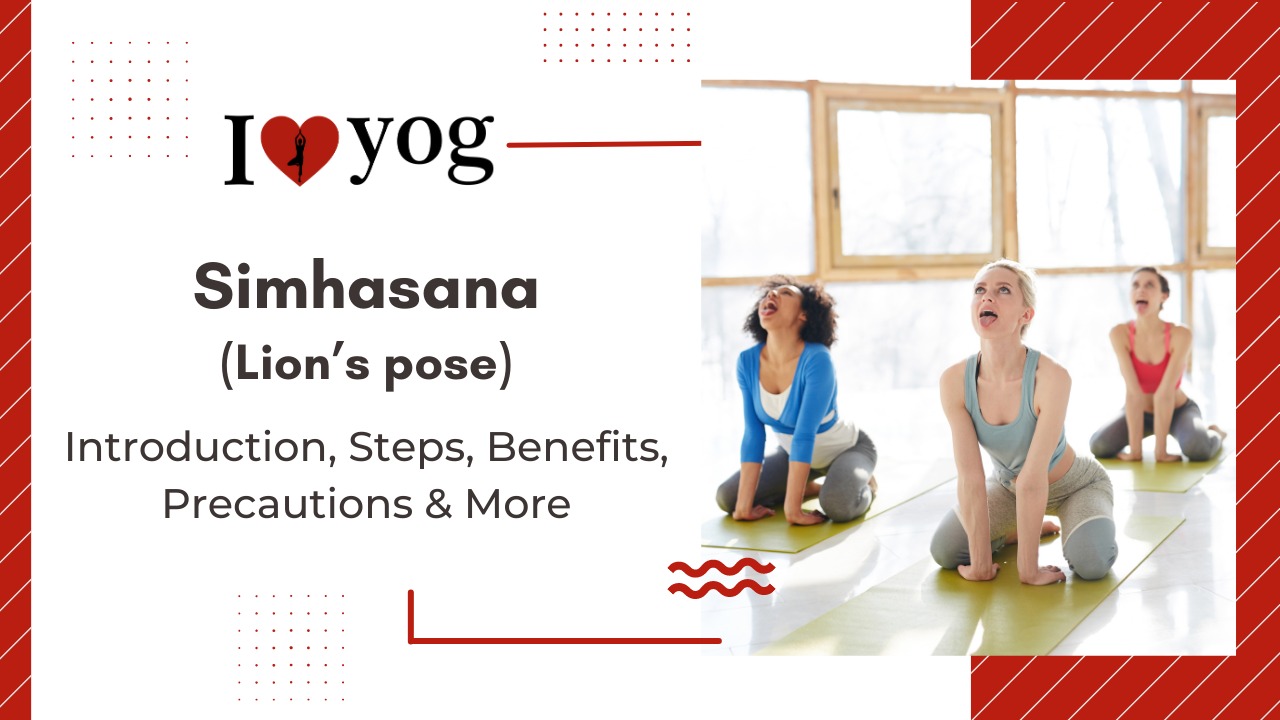What You Need to Know Before Attempting Lion Asana?
Preparatory Poses
- Baddha Konasana
- Dandasana
- Siddhasana or Sukhasana
- Supta Virasana
- Supta Baddha Konasana
- Virasana
- Yogasana Level – Intermediate
- Yogasana Position – Seated and Stretching
- Yogasana Repetitions – none
- Yogasana Strengthens – throat, lungs, and human voice.
- Yogasana Stretches –
The Effect of lion Asana on the tri dosha
How to Perform the Lion Yoga Asana?
- Assume a kneeling position in vajrasana. Spread your knees as widely as you can.
- Lean forward and rest your palms on the floor between your legs with your fingers facing back towards your body.
- Open your eyes and concentrate in the middle of your brow.
- Close your mouth and breathe deeply while you relax your body.
- Exhale through the mouth, protrude the tongue, and emit a loud, distinct “haa” sound.
- Close the mouth and inhale through the nose once again.
What are the advantages of lion yoga posture?
- Relieves tension in the face and chest
- Improves blood circulation to the face
- Maintains healthy eyes by stimulating nerves
- Stimulates and firms the platysma
- Prevents sore throat, asthma, and other respiratory disorders
- May help treat foul breath, supposed to eradicate sickness
- This asana is an excellent anti-aging exercise. It diminishes fine lines, eliminates crow’s-feet (wrinkles around the eyes), and gives the face a fresh glow.
- Simhasana is particularly good for those who have stiffness in the jaws or other discomfort such as teeth grinding, clenched jaws, or an uneven bite.
- Fixing one’s attention while performing Simhasana relieves the problem of burning eyes.
Contraindications And Warnings Regarding Lion Pose/Asana?
- Recent or persistent knee, face, neck, or tongue injury
- In the event of an injury, you can perform Simhagarjanasana while seated on a chair.
- If your wrists are weak, you shouldn’t place your hands on the floor.
- Do not overstretch your mouth when yelling, as this might cause strain.
- If you feel dizzy, avoid looking in the center of the eyebrows. Try it for only a few seconds before looking away.
- Pay close attention to pranayama if you are a beginner and try to learn it from a yoga professional.
- Presently, there are a variety of online yoga programmes from which you can study yoga while practising at home.
- Attempt to practice the Lion Pose face yoga pose on an empty stomach in the morning.
What’s the Science Behind Lion Pose/Asana?
Simhasana is an effective way to release bad energy. Exhaling forcefully and engaging the arms and shoulders are manifestations of the inward release of negative energy. It is believed that many problems stem from internalized anger and resentment, and simhasana releases this energy. To feel the full advantages of the exhalation, it must be powerful and full of intention, not half-hearted.
Tips For Beginners Regarding Lion Pose/Asana?
The hands and shoulder blades are related sympathetically. As you place your right palm on your right knee, you should feel the shoulder blade spreading over your back. Similarly, as you press each hand against the knee on the same side, you should feel how the shoulder blade on the same side presses more deeply into the back, helping to lift the heart.
Advanced Changes in Pose
- Spread the knees wide, bringing the toes together behind the hips, and position the palms flat with the fingers pointed toward the body.
- Assume the position known as Mandukasana (Frog Pose; manduka = frog). Kneel on the ground and sit back on your heels; then, wriggle your buttocks down into the inner arches of your feet, which form a saddle. Then, while maintaining contact between the inner tips of your big toes, open your knees at least as wide as your outer hips. Now, tilt your torso forward and place your palms on the ground between your legs with your fingers toward your pelvic region. Maintain as straight elbows as possible.
Related Yoga Poses/Asanas –
Follow-up Poses
At or near the beginning of an asana or pranayama practice, Simhasana is an excellent way to “clean the air,” so to speak. Therefore, practically, any stance could be practiced next.
Reference:-
- https://www.yogajournal.com/practice/energetics/pranayama/lion-pose/
- https://www.yogapedia.com/definition/6745/simhasana


